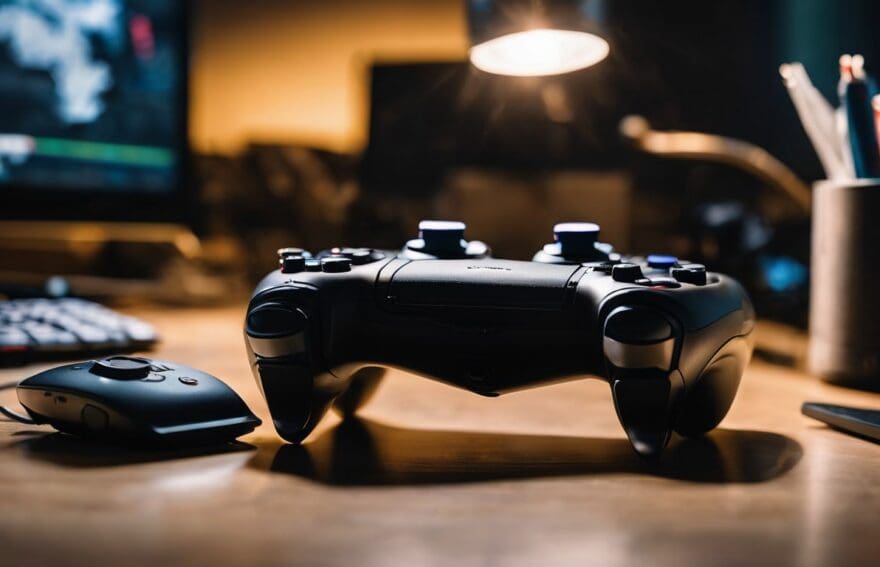Accessibility Tech: Making Esports Inclusive for All Players

Updated On: November 13, 2025 by Aaron Connolly
Gaming ought to be a delight that’s open to all, yet the thrill of esports can sometimes seem just out of reach for some. We fully understand that niggle of disappointment and recognise that with over 216 million Americans enjoying video games, it’s clear there’s a call for wider inclusivity.
Our forthcoming article thoughtfully addresses this issue, offering hands-on solutions ranging from thoughtful game design tweaks to bespoke controllers tailored for gamers of all abilities.
Join us as we explore an inclusive gaming landscape where the magic of esports welcomes each and every player with open arms!
Understanding the Need for Accessibility Testing in Gaming
Recognising the crucial role of inclusivity, we see that accessibility testing in gaming is more than a nice-to-have—it’s essential for empowering gamers with disabilities. It goes beyond just adding a few features; it’s about deeply understanding and meeting diverse needs to create an engaging experience for everyone.
With over 216 million American gamers and many more worldwide, ensuring games are accessible means not ignoring a significant portion of our community.
We conduct thorough accessibility testing because every player deserves to enjoy the thrill of esports without barriers. This involves meticulously exploring how different players interact with our games, their challenges, and what can be improved.
Our commitment to inclusive gaming technology pushes us to consistently innovate and implement features like customisable controls, audio descriptions, and colour-blind modes – all aimed at making esports enjoyable for those who have been sidelined too long.
By embracing universal design principles from the start, we’re opening doors for all abilities to experience the excitement of competitive play.
Enhancing Game Accessibility: 5 Key Strategies
Prioritising accessibility in design and setup is crucial for making esports inclusive. From improving user interfaces to providing compatibility with hardware for gamers with disabilities, these strategies are essential for creating an accessible gaming experience.
Prioritising accessibility in design and setup
Designing and setting up games with accessibility in mind ensures that all players, regardless of ability, can enjoy a seamless and inclusive gaming experience. Incorporating various accessibility features into game design, such as customisable controls, adjustable difficulty levels, and subtitles for audio cues, promotes equal opportunity gaming.
By prioritising accessibility from the outset, we can create an environment where every player feels valued and included. Embracing inclusivity in game design opens up new opportunities for individuals with disabilities to participate in esports events and engage with the wider gaming community.
Implementing accessible design principles enhances the overall user experience and promotes equality within the gaming industry. Game developers are recognising the importance of creating adaptive designs that cater to a diverse player base while fostering an inclusive environment for all abilities.
Improving user interfaces
Game developers are integrating user-friendly interfaces to make gaming experiences more accessible for all players. Clear and intuitive menus, customisable display options, and adjustable control settings are being prioritised to cater to the diverse needs of gamers.
These improvements not only enhance accessibility but also ensure that every player can navigate the game interface with ease, promoting an inclusive gaming environment. As we continue to refine and perfect user interfaces, we are striving towards creating a gaming experience where everyone feels empowered and included.
Moving on to “Compatibility with hardware for gamers with disabilities” – let’s explore how game development is adapting to cater to diverse player needs.
Compatibility with hardware for gamers with disabilities
Expanding on the efforts to improve user interfaces, game developers are prioritising compatibility with hardware for gamers with disabilities. Making games accessible means ensuring that all players can use adaptive equipment and assistive devices without barriers.
The incorporation of accessibility features in gaming software paves the way for adaptive hardware developed by mainstream game companies.
Adaptive technology is vital for creating a more inclusive esports environment, breaking down barriers and allowing everyone to participate in the gaming community. The rise in accessible gaming has already positively impacted over 216 million Americans who regularly play video games, demonstrating an increasing need for compatible hardware that caters to gamers with disabilities.
Audio accessibility
Game developers are incorporating audio accessibility features that cater to players with hearing impairments. These features include visual cues for sound effects, subtitles for spoken dialogue, and adjustable volume controls.
Additionally, advancements in spatial audio technology enhance the gaming experience by providing better directional awareness through sounds, benefitting all players.
Inclusive game design ensures that no player is left behind due to auditory limitations. The integration of audio accessibility not only guarantees an immersive experience for all players but also promotes inclusivity within the esports community.
Real user testing
When considering the effectiveness of accessibility features in gaming, real user testing is crucial for gaining valuable insights into the usability of these features. By involving gamers with diverse abilities in the testing process, developers can gather meaningful feedback on the functionality and practicality of accessibility options.
This hands-on approach ensures that gamers’ needs are accurately represented, leading to more inclusive and user-friendly gaming experiences. Involving real users in testing also aligns with the push towards creating a more accessible and diverse esports environment, ultimately promoting equality and inclusivity within the gaming community.
The Role of Sound in Gaming Accessibility
Innovations in game sound design have significantly improved accessibility for gamers with hearing impairments, creating a more inclusive gaming experience. The impact and benefits of audio accessibility in gaming cannot be overstated, as it opens up the world of esports to a wider audience.
Innovations in game sound design
Game sound design has seen remarkable innovations, paving the way for more immersive and accessible gaming experiences. Developers are integrating dynamic audio cues, spatial sound technologies, and customisable audio settings to cater to a diverse range of player needs.
These advancements not only enhance the overall gameplay experience but also benefit players with visual impairments or hearing disabilities. As a result, gamers can rely on auditory feedback for crucial game information, contributing to a more inclusive gaming environment that embraces all abilities.
By incorporating innovative sound designs, games become more engaging and accessible for a broader audience. Spatial audio technology enables players to accurately locate in-game events based on realistic sounds and their directionality.
The impact and benefits of audio accessibility
Game sound design has a significant impact on gaming accessibility, as it enables players with visual impairments to navigate the game environment using audio cues. Audio accessibility benefits not only those with vision impairments but also enhances the overall gameplay experience for all players.
Inclusive audio features such as audio descriptions and sound cues not only provide crucial information during gameplay but also contribute to a more immersive and engaging gaming experience for all abilities.
Innovations in game sound design have led to heightened awareness of the importance of audio accessibility, making games more enjoyable and accessible for a wider audience. The incorporation of audio accessibility features in mainstream games promotes equality in gaming and encourages inclusivity within the esports community, helping to create an environment where every player can fully participate and enjoy the thrill of competitive gaming.
Creating Accessible Game Controllers
Players with disabilities often struggle to find controllers that suit their needs, but advancements in controller design have opened up new possibilities for inclusive gaming experiences.
These innovations are helping to level the playing field and make esports accessible for all players.
The demand for accessible controllers
Game controllers are in high demand, with players across the gaming community seeking more accessible options. Companies have recognised this need and are developing innovative controller designs to cater to a wider range of gamers, including those with disabilities.
With these advancements, players can look forward to a more inclusive gaming experience that accommodates diverse needs and preferences.
As game developers continue to prioritise accessibility, the availability of adaptive controllers is increasing, offering more choices for players of all abilities. These developments align with the growing emphasis on creating an inclusive esports environment where every gamer can participate fully and enjoy the thrill of competitive play.
Advancements in controller design
Game controllers have seen significant advancements to accommodate gamers with diverse needs. Manufacturers are integrating features such as customisable button mapping, adaptive triggers and joysticks, and enhanced haptic feedback to cater to a wider range of abilities.
These improvements aim to provide more inclusive gaming experiences by allowing players to personalise their controller setup according to their specific requirements, promoting greater accessibility and equality in gaming.
The development of accessible game controllers is crucial in ensuring that all players can fully engage in the esports community. By incorporating these innovations, mainstream game companies are taking positive strides towards creating an environment where every gamer feels empowered and included.
Conclusion: Embracing Inclusivity in Esports.
Embracing inclusivity in esports is crucial for creating a gaming environment that welcomes all players. Accessibility technology and inclusive design are breaking down barriers, allowing everyone to participate in the gaming community.
Advancements in gaming accessibility and adaptive hardware are paving the way for a more diverse and inclusive esports landscape. Making esports accessible for all players is not just an option but a necessity to ensure that everyone can enjoy and excel in the world of competitive gaming.
The ongoing commitment to making esports inclusive ensures that all gamers have the opportunity to engage and compete at their best ability.
FAQs
1. What is accessibility tech in the world of esports?
Accessibility technology in esports refers to tools and features that make gaming inclusive for players with disabilities, such as accessible controllers and adaptive gaming equipment.
2. How does assistive technology help gamers with disabilities?
Assistive technology allows gamers with disabilities to enjoy esports by providing customised controllers and software enhancements tailored for easy access and gameplay.
3. Are there esports events that are inclusive of all abilities?
Yes, there are inclusive esports events designed to promote equality in gaming, ensuring players regardless of their abilities can compete and participate fully.
4. What kinds of advancements have been made in gaming accessibility?
Recent advancements in gaming accessibility include the development of disability-friendly controllers, accessibility features for games, and assistive devices enabling those with impairments to play without barriers.
5. Can anyone get involved in accessible esports?
Absolutely! With accessible gaming options now increasingly available, it invites people from all walks of life to join, creating a diverse environment where everyone can game together.


